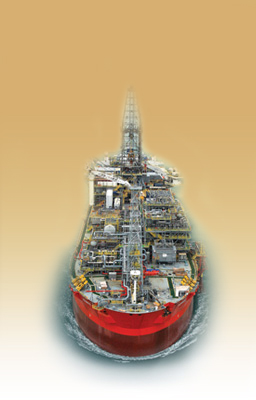 ey document: Environmental Impact Statement (EIS), issued by MMS in 2000. (This document is 793 pages long, so it may take some time to download.)
ey document: Environmental Impact Statement (EIS), issued by MMS in 2000. (This document is 793 pages long, so it may take some time to download.)
As the Record of Decision stated in late 2001: "In 1996, OCS operators, as well as builders and operators of FPSO vessels, began having serious discussions with the MMS about the possibility of using FPSO systems in the Gulf of Mexico".
DeepStar took the initiative on behalf of the industry to fund and support an EIS, which was a requirement for the project. DeepStar enlisted the support of operators, classification societies and FPSOs designers and contractors, all such that FPSOs could be included in the "toolbox" of field development options for deepwater GOM.
The approval effort for FPSOs also covered an approval process for shuttle tankers, since they would be required to deliver the crude oil production from the FPSOs to refineries.
Regulatory approval of FPSOs for GOM meant that petroleum related-production matters as well as vessel safety matters had to be addressed. After discussions, a Memorandum of Understanding (MoU) was negotiated which defined how the USCG and the MMS would collaborate in approving different parts of the design, construction and operation of FPSOs for GOM.
The MOU was published in the Federal Register on January 15, 1999 in pages 2260-2267 and was included in the EIS as Appendix A in pages 757-764.
The policy decision of the MMS to accept the use of FPSOs in GOM, subject to certain limitations, is given in the 37th page Record of Decision that was signed on December 13, 2001.
The MMS then announced it was ready to accept applications for the use of FPSOs in GOM in its press release on January 2, 2002.
Despite the willingness of the MMS to accept such applications, none came forward until years later. The success in achieving this acceptance and the question of what it would take to move forward with FPSOs was the inspiration behind the FPSO Global Workshop held later in 2002 and a related event in 2003 on DeepWater Oil Transportation to address the potential use of shuttle tankers to bring production from FPSOs to GOM refineries.
The discussion here is obviously about early history: post Macondo in 2010 the function of MMS was split in two:
BSEE - Bureau of Safety and Environmental Enforcement www.bsee.gov
BOEM - Bureau of Ocean Energy Management www.boem.gov
